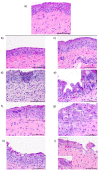Immune Responses in the Eye-Associated Lymphoid Tissues of Chickens after Ocular Inoculation with Vaccine and Virulent Strains of the Respiratory Infectious Laryngotracheitis Virus (ILTV)
- PMID: 31295877
- PMCID: PMC6669519
- DOI: 10.3390/v11070635
Immune Responses in the Eye-Associated Lymphoid Tissues of Chickens after Ocular Inoculation with Vaccine and Virulent Strains of the Respiratory Infectious Laryngotracheitis Virus (ILTV)
Abstract
Infectious laryngotracheitis (ILT) is an acute respiratory disease of poultry caused by infectious laryngotracheitis virus (ILTV). Control of the disease with live attenuated vaccines administered via eye drop build upon immune responses generated by the eye-associated lymphoid tissues. The aim of this study was to assess cytokine and lymphocyte changes in the conjunctiva-associated lymphoid tissues (CALT) and Harderian gland (HG) stimulated by the ocular inoculation of the ILTV chicken embryo origin (CEO) vaccine strain and virulent strain 63140. This study offers strong evidence to support the roles that the CALT and HG play in the development of protective ILTV immune responses. It supports the premise that ILTV-mediated immunomodulation favors the B cell response over those of T cells. Further, it provides evidence that expansions of CD8α+ cells, with the concomitant expression of the Granzyme A gene, are key to reducing viral genomes in the CALT and halting ILTV cytolytic replication in the conjunctiva. Ultimately, this study revealed that the early upregulation of interleukin (IL)-12p40 and Interferon (IFN)-γ cytokine genes, which shape the antigen-specific cell-mediated immune responses, retarded the decline of virus replication, and enhanced the development of lesions in the conjunctiva epithelium.
Keywords: Granzyme A; Harderian gland (HG); Interferon-γ gene; conjunctiva-associated lymphoid tissue (CALT); infectious laryngotracheitis virus (ILTV); interferon gamma; interleukin-12p40 gene; viral genome load.
Conflict of interest statement
The authors declare no conflict of interest.
Figures








Similar articles
-
Ocular exposure to infectious laryngotracheitis virus alters leukocyte subsets in the head-associated lymphoid tissues and trachea of 6-week-old White Leghorn chickens.Avian Pathol. 2020 Aug;49(4):404-417. doi: 10.1080/03079457.2020.1757036. Epub 2020 May 19. Avian Pathol. 2020. PMID: 32301627
-
The route of inoculation dictates the replication patterns of the infectious laryngotracheitis virus (ILTV) pathogenic strain and chicken embryo origin (CEO) vaccine.Avian Pathol. 2017 Dec;46(6):585-593. doi: 10.1080/03079457.2017.1331029. Epub 2017 Jun 19. Avian Pathol. 2017. PMID: 28532159 Review.
-
Evaluation of the transcriptional status of host cytokines and viral genes in the trachea of vaccinated and non-vaccinated chickens after challenge with the infectious laryngotracheitis virus.Avian Pathol. 2016;45(1):106-13. doi: 10.1080/03079457.2015.1126804. Avian Pathol. 2016. PMID: 26926298
-
Comparative in vivo safety and efficacy of a glycoprotein G-deficient candidate vaccine strain of infectious laryngotracheitis virus delivered via eye drop.Avian Pathol. 2011 Aug;40(4):411-7. doi: 10.1080/03079457.2011.588686. Avian Pathol. 2011. PMID: 21812721
-
Immune responses to infectious laryngotracheitis virus.Dev Comp Immunol. 2013 Nov;41(3):454-62. doi: 10.1016/j.dci.2013.03.022. Epub 2013 Apr 6. Dev Comp Immunol. 2013. PMID: 23567343 Review.
Cited by
-
Characterization of infectious laryngotracheitis virus isolated from commercial layer chickens in Bangladesh during the year 2021-2022.J Adv Vet Anim Res. 2024 Jun 9;11(2):398-407. doi: 10.5455/javar.2024.k789. eCollection 2024 Jun. J Adv Vet Anim Res. 2024. PMID: 39101088 Free PMC article.
-
In Ovo Vaccination with Recombinant Herpes Virus of the Turkey-Laryngotracheitis Vaccine Adjuvanted with CpG-Oligonucleotide Provides Protection against a Viral Challenge in Broiler Chickens.Viruses. 2023 Oct 17;15(10):2103. doi: 10.3390/v15102103. Viruses. 2023. PMID: 37896880 Free PMC article.
-
Effect of CpG-Oligonucleotide in Enhancing Recombinant Herpes Virus of Turkey-Laryngotracheitis Vaccine-Induced Immune Responses in One-Day-Old Broiler Chickens.Vaccines (Basel). 2023 Jan 29;11(2):294. doi: 10.3390/vaccines11020294. Vaccines (Basel). 2023. PMID: 36851171 Free PMC article.
-
Do Activity Sensors Identify Physiological, Clinical and Behavioural Changes in Laying Hens Exposed to a Vaccine Challenge?Animals (Basel). 2025 Jan 14;15(2):205. doi: 10.3390/ani15020205. Animals (Basel). 2025. PMID: 39858205 Free PMC article.
-
Host-virus interactions during infection with a wild-type ILTV strain or a glycoprotein G deletion mutant ILTV vaccine strain in an ex vivo system.Microbiol Spectr. 2025 Feb 4;13(2):e0118324. doi: 10.1128/spectrum.01183-24. Epub 2025 Jan 13. Microbiol Spectr. 2025. PMID: 39804092 Free PMC article.
References
-
- García M., Spatz S., Guy J. Infectious laryngotracheitis. In: Swayne D.E., Glisson J.R., McDougland L.R., Nolan L.K., Suarez D.L., Nair V.L., editors. Diseases of Poultry. 13th ed. Wiley-Blackwell; Ames, IA, USA: 2013. pp. 161–179.
Publication types
MeSH terms
Substances
LinkOut - more resources
Full Text Sources
Medical
Research Materials

